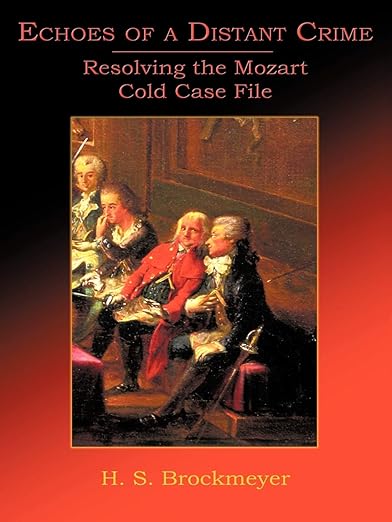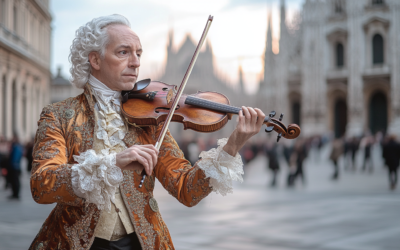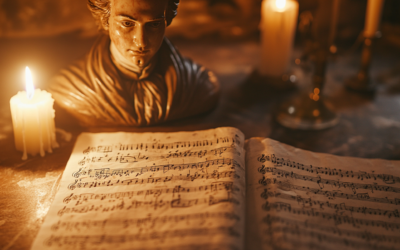Constanze Mozart’s Enduring Love
Myths, Misconceptions, and Mysterious Graves
Although some have doubted her devotion, Constanze’s own words and actions illustrate a widow deeply committed to preserving Mozart’s legacy. Diaries, personal correspondence, and eyewitness testimony all challenge the notion that she neglected his memory—while the circumstances around his burial grow ever more perplexing.
“He was of so sweet a disposition altogether that it was impossible to argue with him…”
Constanze
In H. S. Brockmeyer’s latest analysis, the widely debated affection of Constanze Mozart for her first husband, Wolfgang Amadeus Mozart, is re-examined through letters, visitors’ accounts, and a host of little-known historical records. Critics have often accused Constanze of neglecting Mozart’s memory by failing to erect a proper headstone for him, yet, as Brockmeyer highlights, her day-to-day actions speak volumes about her loyalty and her heartbreak.
Constanze’s diary entry of 11 August 1829, lovingly referencing Mozart’s fortepiano—where he reportedly composed the Zauberflöte, La Clemenza di Tito, the Requiem, and a Freemason Cantata—demonstrates her lifelong attachment. Despite the hardships and misunderstandings in their marriage, she cherished this instrument, eventually sending it to her eldest son, Karl. Moreover, she traveled with a treasured painting of Mozart, by her brother-in-law Joseph Lange, safeguarded in a custom-made wooden case. The English musician and publisher Vincent Novello, along with his wife Mary, visited Constanze in 1829 and confirmed her unwavering devotion. As Mary wrote in her journal, Constanze proudly displayed the painting, the famous inkstand permanently stained with Mozart’s ink, and even locks of his hair—a sentimental gesture that leaves little doubt about her profound feelings.
One of the many overlooked details, Brockmeyer points out, is the monumental gravestone currently crowning the final resting place of Constanze’s second husband, Georg Nissen, in Salzburg’s St. Sebastian Church cemetery. Today, the name MOZART gleams in gold on that shared stone, an homage to Constanze’s first husband that endures for centuries—an act entirely consistent with a woman who would not allow her beloved to be forgotten. Yet the research also calls attention to the contradictions regarding Leopold Mozart’s grave, which ended up in a communal burial site rather than near the grand Nissen headstone. The confusion, incomplete records, and repeated renovations contribute to a sense of unresolved mystery surrounding the family’s final resting places.
In parallel, the controversy about Mozart’s alleged grave at St. Marx in Vienna adds an extra dimension of intrigue. Scholars, tourists, and enthusiasts have paid homage to a cenotaph believed to mark the spot where Mozart might lie, but the revelations unearthed by H. S. Brockmeyer indicate that there is no definitive proof of the composer’s remains in that location. In fact, subsequent attempts to verify whether bones found in Salzburg could be those of Mozart or his relatives—particularly the 2004 and 2005 forensic investigations—ended with inconclusive DNA results. The same is true of the famed skull, purported to be Mozart’s, which has yet to be verified scientifically and remains in the care of the Mozarteum Foundation.
Particularly fascinating are the shadowy details surrounding Mozart’s final days: the contradictions in eyewitness testimony about who visited him, the confusion regarding a simple or third-class funeral, and the complete lack of the grand commemorations that one might expect for a composer whose music so electrified Vienna. By contrast, the city of Prague honored Mozart with an elaborate memorial service on 14 December 1791, while Vienna seemingly carried on without public ceremonies—an oversight that continues to puzzle historians.
Brockmeyer also introduces an astonishing story that places Mozart’s corpse in the Freihaus Theater of his friend and collaborator Emanuel Schikaneder, who staged The Magic Flute. An eyewitness account suggests that the composer’s body was briefly laid out there, although official records remain silent on the matter. This bizarre episode dovetails with the enduring rumor that Mozart’s physical remains simply vanished from public sight. According to local anecdotes, neither the Church nor the authorities possessed clear or consistent documentation as to where or how he was buried.
By interweaving testimony from Constanze, Sophie Haibl (Constanze’s sister), the Novellos, and forensic experts centuries later, Brockmeyer paints a picture of a widow doing all in her power to safeguard the memory of “her inexpressibly beloved husband,” in the face of church procedures, royal edicts, and myriad forces beyond her control. This first installment of H. S. Brockmeyer’s comprehensive study peels back layer after layer of myth and speculation—revealing a steadfast love that contradicts long-held assumptions about Constanze’s indifference.
Stay tuned for Part II, in which H. S. Brockmeyer delves even further into the convoluted archives, possible political and ecclesiastical motivations, and the broader historical context that shaped Mozart’s fate and legacy. How did Austria’s Catholic Church and the imperial authorities handle such a high-profile death? And why were so many of Vienna’s influential Freemason brothers conspicuously silent at Mozart’s funeral? The journey into this enigma continues.
You May Also Like
The Echo of the Pummerin Bell
The powerful resonance of the Pummerin bell in Vienna may have influenced Mozart’s compositions, particularly Sarastro’s arias in The Magic Flute.
The Hidden Influence of Joseph Boulogne, Chevalier de Saint-George
Joseph Boulogne, known as the “Black Mozart”, was shaping the future of music while Mozart was still struggling for recognition in Paris. But history has buried the significant influence Saint-George had on Mozart’s career, erasing his pioneering style from the narrative.
The Forgotten Viennese Quartets
Attributing Offertorium K.34 to Mozart is not just misleading, it reflects the careless methods used by 19th-century scholars to inflate his legacy. Without an autograph or solid evidence, this work should not be considered part of his output.”
Mozart’s Bassoon Concerto: A Question of Authorship
The Bassoon Concerto K.191 raises more questions than it answers. Long thought to have been composed for a Munich bassoonist, new evidence suggests Mozart had no clear performer in mind. The concerto’s disjointed movements and other dubious compositions attributed to Mozart add further complexity to his legacy
The Uncertain Origins of Mozart’s Early String Quartets
Mozart’s so-called “Milanese Quartets” (K.155, 158, and 159) have long been subject to debate, primarily due to their ambiguous instrumentation and structural weaknesses. Were these works part of a larger series of orchestral divertimenti, hastily repurposed as string quartets? The answer remains elusive, reflecting the young composer’s struggles to find his own voice.
Simplicity, Errors, and the Myth of Perfection
Mozart’s canons are not as complex as often claimed, with notable errors in K.553 and K.554, and the myth of “V’amo di cuore teneramente” K.348 being debunked.







